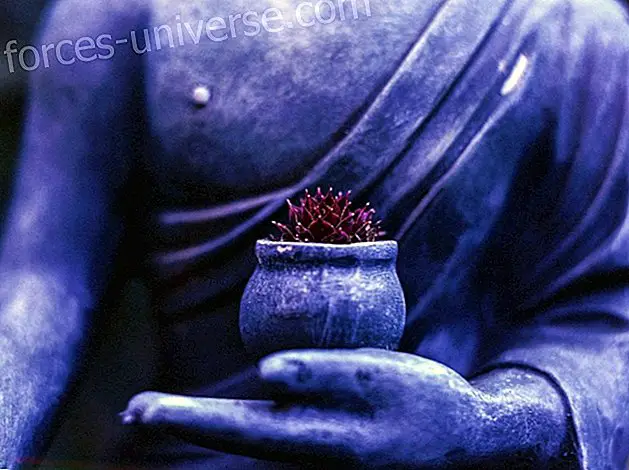Buddha of Tibetan Medicine: Symbology, bases and foundations of this practice of ancient health
- 2019

"No one will punish you for your anger, it will be your anger that punishes you."
- Buddha
Approximately forty years ago, Dr. Yeshi Dondhen, who was the private doctor of the Dalai Lama, dedicated a series of talks to tell us about Tibetan Medicine, and from that moment, in the western world he has aroused growing curiosity and interest.
Like everything related to this fascinating culture, symbolism should not surprise us in its practice, and the Buddha of Tibetan medicine is the one who appears in this case.
We will then see the characteristics of this type of medicine and this manifestation of the Buddha.
The Buddha of Tibetan medicine
In this culture, the Buddha is said to be the doctor who cures duḥkha (' suffering '), the root of all evil.
In traditional iconography, the Buddha of Tibetan medicine is represented in blue, derived from lapis lazuli .
This stone has been associated for thousands of years with the healing of the sick. It is believed that in the ancient legend of the goddess Ishtar of the Sumerian civilization, she descends to the underworld to rescue her loving brother, and it is her lapis lazuli necklace that protects her from the dangers of her journey through hell.
Either way, it is a blue stone with golden streaks, and from there the Buddha of Tibetan medicine takes its color.
This image also shows us that in his right hand he holds a bowl adorned with bright stones, and in the other the birth of a medicinal plant . It is believed that this is a spike of the Terminalia Chebula plant, native to the south of the Asian continent.
The Buddha's practice of Tibetan medicine is not only a powerful method of healing, but also for overcoming states of attachment, ignorance and hate. That is to say, meditation on the Buddha of Tibetan medicine also helps to reduce mental illness and suffering.
- Read also The origin of Mindfulness -
The basis of Tibetan medicine
The practice of Tibetan medicine finds its basis in the culture of Buddhism, and in the same way, it is based on the four Noble Truths of the Buddha.
These are:
- The whole existence is duḥkha ('suffering').
- This suffering comes from desire, attachment and ignorance.
- This suffering can be overcome.
- The way to overcome it is through the Noble Eightfold Path
In turn, the Noble Eightfold Path involves:
- The right understanding
- The right thought
- The right word
- The right action
- The right occupation
- The right effort
- The right attention
- The correct concentration
Read also Interview with Iama Tulku Lobsang, the doctor of Tibet

Principles of Tibetan Medicine
As the Buddha of Tibetan medicine teaches us, this practice is based on directly treating the so-called three humors . These are bile ( gut ), wind ( lung ) and phlegm ( beken ). These three vital substances of the body are responsible for all the functions that occur within us. In turn, diseases are nothing more than imbalances that occur in these three moods due to ignorance (the conception of 'ignorance' in this culture is a mental state in which the individual does not know the way in which the Everything works and therefore, the nature of the phenomena).
Anyone who wishes to learn to practice this type of healing should memorize the Four Tantras of the Buddha of Tibetan medicine within 5 years of the study.
The First Tantra, or Tantra Root is a very short book that introduces the general notions of this type of medicine.
The Second Tantra, or Explanatory Tantra is a more detailed book about pregnancy processes, anatomy, different symptoms, the characteristics of each of the moods, etc. This also goes into detail about what makes a good diet and good behavior.
The Third Tantra or the Tantra of the Oral Tradition is an extensive book detailing the different types of diseases, causes and forms of therapy.
Finally, the Fourth Tantra or Final Tantra is in which the ways of diagnosing are detailed, such as the analysis of the urine or the taking of the pulse.
- Read also The meaning of the five Buddha statues -
The disease according to the Buddha of Tibetan medicine
Broadly speaking, Tibetan medicine manages to condense all the disorders into four hundred and four diseases . Then he analyzes the different origins of each one.
Of the total, one hundred and one disorders are directly related to the karma of past lives . Usually, the weight of this karma is enough to lead the sick to death. In fact, for these cases the total disposition to spiritual practice is recommended, and even healing cannot be guaranteed.
Another hundred and one disorders of total diseases find their roots in the karma that has been generated in this life. In this case, the causes can often be traced years or even decades before treatment. As in the previous ones, the Buddha of Tibetan medicine tells us that in these cases we must focus on spiritual practice to clean our impurities.
Of the two hundred and two diseases that remain, one hundred are related to eating or behavioral disorders, and the rest are related to evil spirits .
As you know, Tibetan medicine tells us about entities that are not visible to the human eye, but have the ability to harm us. This is what happens in these cases in which a cause is not found to the disease, and the individual is faced with great suffering.
According to the Buddha of Tibetan medicine, this type of disorder requires a spiritual practice such that the exorcism of the spirit is carried out . Only then will the person get healed.
- Read also the best Yoga videos for beginners -

The mantra of the Buddha of Tibetan medicine
To achieve a deep and receptive connection with patients, practitioners of this type of medicine usually recite the Buddha's mantra of Tibetan medicine every morning.
Through the visualization of the image of this Buddha inside, they recite the syllables to improve their attention span, understanding the roots of the disease, intuition and their ability to heal. In this way, they manage to enhance the benefits of treatment for their patients.
The mantra of the Buddha of Tibetan medicine is as follows:
Teyatha: Om Bekanze Bekanze Maha Bekanze Radza Samut Gate Soha
It could be translated as 'I invoke the essence of being and all the power of healing be present in me, to heal the disease and awaken from ignorance '.
In order to carry out this invocation effectively, the practice of meditation is recommended to set aside those thoughts that hinder concentration. For this, try to find a space where you are calm, and you can sit with your back straight. Then you can close your eyes, or keep them open pointing towards the tip of your nose. Take three deep breaths, and when you exhale, recite the syllable OM . At this point you can already recite the Buddha's mantra of Tibetan medicine, repeating it again and again. Then, you can close the cycle with three deep breaths, again accompanied by OM syllable when exhaling.
The practice of Tibetan medicine is very interesting, and is constantly proposed as a discipline in the area of health that many and great benefits can offer us for our own well-being.
Remember, health comes first.
AUTHOR: Lucas, editor and translator of the great family of hermandadblanca.org
SOURCES:
- https://www.quecursar.com/noticias/principios-basicos-del-Buda-de-la-medicina-para-sanadores-9969.html
- https://tulkulobsang.org/es/conocimientos-tibetanos/tibetan-medicine
- https://escuelamedicinatibetana.wordpress.com/2015/10/19/el-mantra-del-Buda-azul/
- https://corphilium.com/medicina-tibetana/
- https://en.wikipedia.org/wiki/Bhaisajyaguru#Iconography






